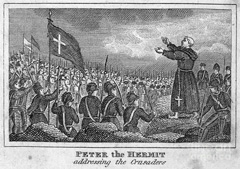Peter the Hermit dies 1115
Submitted by walwyn Peter was born around 1050 in Amiens, Picardy in northern France. Most likely a priest of humble background; some sources suggest he lived for a time as a hermit or ascetic. Medieval accounts (often legendary) claim he tried to visit Jerusalem before the Crusade and was mistreated by Muslims, inspiring his zeal to free the Holy Land. After Pope Urban II proclaimed the First Crusade at Clermont in 1095, Peter became one of the most charismatic grassroots preachers of the cause. Unlike the noble leaders, Peter’s appeal was to peasants, townsfolk, minor knights, women, and even children. He stirred vast crowds (estimates range from 15,000 to 40,000), with fiery sermons, reportedly riding a donkey and dressed in rags, emphasizing humility and divine mission. This army was poorly organized, poorly armed, and not sanctioned by proper feudal lords. They departed months before the official crusading armies, which were still assembling.
Peter was born around 1050 in Amiens, Picardy in northern France. Most likely a priest of humble background; some sources suggest he lived for a time as a hermit or ascetic. Medieval accounts (often legendary) claim he tried to visit Jerusalem before the Crusade and was mistreated by Muslims, inspiring his zeal to free the Holy Land. After Pope Urban II proclaimed the First Crusade at Clermont in 1095, Peter became one of the most charismatic grassroots preachers of the cause. Unlike the noble leaders, Peter’s appeal was to peasants, townsfolk, minor knights, women, and even children. He stirred vast crowds (estimates range from 15,000 to 40,000), with fiery sermons, reportedly riding a donkey and dressed in rags, emphasizing humility and divine mission. This army was poorly organized, poorly armed, and not sanctioned by proper feudal lords. They departed months before the official crusading armies, which were still assembling.
Peter’s followers passed through the Rhineland, Hungary, and the Balkans. Discipline broke down, and many committed riots, looting, and even massacres of Jewish communities in the Rhineland (especially under Count Emicho’s parallel band). In Hungary, clashes with locals left many crusaders killed or stripped of possessions. Despite the chaos, Peter himself reached Constantinople with a large remnant if his followers.
 The Byzantine Emperor Alexios I Komnenos ferried Peter’s host across the Bosporus to Nicaea in 1096, hoping to keep them from trouble in Constantinople. The Crusade proved militarily useless. Most of Peter’s force was ambushed and annihilated by the Seljuk Turks at the Battle of Civetot (October 1096). Peter though survived as he was back in Constantinople when his forces were ambushed. After the destruction of his army, Peter joined up with the main Crusader forces, led by princes and nobles (Raymond of Toulouse, Bohemond of Taranto, Godfrey of Bouillon, etc.). Participating in the long march and the Siege of Antioch (1097–1098), where sources suggest he briefly tried to desert but was brought back. Eventually he was present during the Siege of Jerusalem (1099) and witnessed the capture of the city.
The Byzantine Emperor Alexios I Komnenos ferried Peter’s host across the Bosporus to Nicaea in 1096, hoping to keep them from trouble in Constantinople. The Crusade proved militarily useless. Most of Peter’s force was ambushed and annihilated by the Seljuk Turks at the Battle of Civetot (October 1096). Peter though survived as he was back in Constantinople when his forces were ambushed. After the destruction of his army, Peter joined up with the main Crusader forces, led by princes and nobles (Raymond of Toulouse, Bohemond of Taranto, Godfrey of Bouillon, etc.). Participating in the long march and the Siege of Antioch (1097–1098), where sources suggest he briefly tried to desert but was brought back. Eventually he was present during the Siege of Jerusalem (1099) and witnessed the capture of the city.
After returning to Europe, Peter is said to have founded a monastery at Neufmoustier near Huy (present-day Belgium), where he died around 1115.
